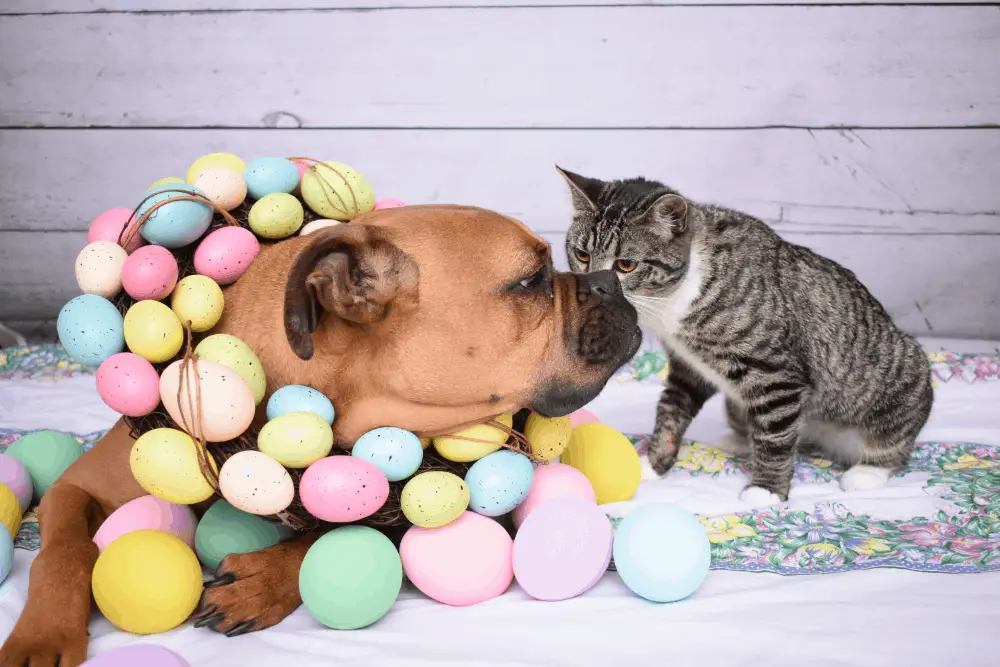Are Boxers Good with Cats?
Boxers in general are considered to be friendly, happy-go-lucky dogs that do well with both children and other pets – including cats. With proper socialization, boxers can coexist with cats without any concerns. Without it, a Boxer may see a cat as prey, and will consistently chase it around the house.
If you are reading this, there’s a good chance that you own a cat and are thinking about getting a boxer.
Alternatively, you may already have a Boxer and are thinking about bringing home a cat.
Either way, you must know if they will get along before you make this important decision.
As we all know, not all dog breeds do well with cats. Some chase them, and some will even attack.
My little French Bulldog loves to play with everyone and everything. So, anytime she is around cats, she chases them, thinking that they will want to play too.
Ninety-nine percent of the time, she is wrong. Cats do not like my dog.
But where do Boxers fall along this spectrum?
Do they coexist well with cats?
Or will the mixture be a disaster?
Let’s delve a little deeper into the topic and answer some important questions like:
- What is the typical Boxer personality like?
- Why is socialization so important?
- I have a cat and want to get a Boxer. How do I introduce the Boxer to my cat?
- I have a Boxer and want to get a cat. How do I go about bringing the cat into my home?
- What are some possible conflict resolution tactics I should know?
Let’s get started.
Typical Boxer Personality

The typical Boxer is friendly, outgoing, playful, energetic, and extremely goofy.
Boxers make excellent companions, and their outgoing personality is one of their best traits.
If they aren’t being silly and trying to make you laugh, there’s a good chance that they will be snuggled up beside you or, if you let them, on your lap.
As just mentioned, Boxers are extremely energetic and playful, and they tend to mature later than most other breeds.
This means that they require plenty of exercise and attention throughout the day to keep their minds and bodies preoccupied.
Puppy behavior is common for this breed for the first few years of life, so if raising a boxer, you should expect some chewed up shoes and holes dug in the garden.
In terms of family, boxers are extremely loyal to their family members, especially children and make excellent guard dogs.[1]
With a boxer around, you will always know when strangers are nearby. Though they are unlikely to become aggressive unless provoked, the Boxer will always warn of strangers by growling or barking.
The breed does well with children and can do well with other animals as well when appropriately socialized from a young age.
When left to their own devices, however, they may become aggressive with other smaller animals that they see as “prey”. Yes, this includes cats.
The Importance Of Socialization

If you want a cat and a Boxer to coexist in the same home, it’s essential that the Boxer is properly socialized from a young age.
Unfortunately, the word “socialization” can be a little misleading.
When taken literally, most people think that socialization refers to teaching a puppy how to get along well with other dogs, cats, and people.
Yes, this is true, but socialization is also so much more than that.
Proper socialization of a puppy doesn’t just involve introducing them to the other animals.
Rather, it is the process of adapting your puppy to a variety of different scenarios that they may encounter later on in life.
Yes, this involves socializing with other animals, but it also involves adapting them to loud noises, car rides, trips to the groomers, and so on.
In other words, proper socialization teaches your puppy to become a well-rounded adult dog that can adapt to, and be comfortable in, a variety of different situations and scenarios.
With proper socialization, a Boxer will quickly learn that cats are a part of everyday life rather than looking at them as prey, which is the natural tendency of a dog.
To reach this stage, it’s vital that dogs are socialized at an early age.
Why?
Because once dogs reach a certain age, they tend to become wary of things they have never encountered before. This can create anxiety, or panic, and can lead to undesirable outcomes as adults.
But by introducing your Boxer to other types of animals, by going to new places, and by meeting new people at a young age, your Boxer can grow to be a well-rounded adult that can take things in stride throughout its life – including a cat.
When should socialization start?
The earlier, the better!
Socialization should start with the breeder, but it’s your responsibility to make sure that it continues at home.
Most puppies are adopted between 8 and 16 weeks of age, and this is the perfect time to start introducing your Boxer to new animals, people, situations, and scenarios.
With that being said, socialization isn’t something that should stop after puppyhood – it should continue throughout your dog’s life.
How Do You Introduce A Boxer To A Resident Cat?

So you have a cat, and are thinking about getting a Boxer – great!
As we already determined, the situation looks hopeful – especially if you are getting a puppy.
The first time bringing your puppy home is an excellent time to introduce them to your cat, and is an excellent start in the process of socialization!
But how do you do this correctly to ensure that both the cat and dog are comfortable with the situation?
Firstly, it’s important to remember that this was your cat’s home first, so you want to do everything you can to keep them comfortable.
Below are the steps to follow when introducing a boxer to a resident cat:
- Create a safe place for your cat (a place where the dog cannot get to) where it can go if it wants its own space.
- Put all of the cat’s necessities in this location – their litter box, their food, their water, etc. If your cat starts to feel frightened or overwhelmed, this will be its own space to go and retreat.
- Take your Boxer for a good walk or run, and give a large meal to ensure that it is relaxed during the interaction.
- Allow your cat to retreat to its safe place, and let the dog roam the house freely for an hour or so. (Not only will this allow the dog time to explore their new home, but it will also give them time to pick up on the smell of the cat.)
- Let your cat acquaint with the dog in the same way. Take your dog out for a short walk, and let the cat sniff your home for the scent of the new dog.
- Keep your Boxer on a leash to prevent them from chasing after the cat. (you may want to keep your Boxer on a leash for the first few days so that you can correct them from chasing after your cat.)
- Provide a quick correction if it tries to chase the cat, and praise the dog the moment that they comply and vice versa.
- Once you notice your Boxer and cat are both comfortable from a distance, you can move a little closer until you finally get a proper introduction.
Remember: First interactions should be short and should start from a distance. You may notice that your cats first reaction is to hiss, but don’t be surprised, this is completely normal.
Important: Do not allow them to roam freely until you are confident that the interaction will be pleasant for both pets.
How Do You Bring A Cat Into A Home With A Boxer?

So you already have a Boxer and are thinking about bringing home a new cat – great!
But before you do so, it’s crucial that you feel assured that the two will get along.
This will be highly dependent on the personality of your Boxer, and the degree to which it has been socialized.
If you are confident that your Boxer has been properly socialized at a young age, introducing a cat to the household properly won’t be a cause for concern.
But if your Boxer tends to chase after other animals, or has anxious tendencies due to improper socialization, bringing a new cat into your house may just wreak havoc among your home.
You know your Boxers personality better than anyone else – so the decision is up to you.
But if you do decide that your Boxer is ready for a feline companion, how can you go about introducing the two?
Here are the steps to follow:
- Start by preparing your dog for the arrival. (Remember, this was their home first, so you want to make sure you do everything possible to keep them comfortable.)
- Give your dog a good meal and take them out for a good run to help exert their energy before the introduction.
- Once the new cat arrives, be sure to give your Boxer plenty of affection and reassurance. Jealousy can quickly lead to aggression, so it’s best to avoid it as much as possible.
- Before allowing your dog and cat to get acquainted, create a safe room for the new cat. (This room should include their litter box, food, water, and anything else you want to add to their space.) This should be a pleasant space where you can put your cat until both pets are comfortable with each other’s presence.
- Before introducing your cat and dog, allow them to become acquainted through smell.[2]
- Upon meeting for the first time, you should place your new cat in their crate, and keep your dog on a leash. (this will allow them to meet each other without any actual physical contact.) During this stage, be sure to give lots of praise.
- If your dog gets too excited, take them into another room until they calm down, and then try again.
- Repeat this activity until both animals seem relaxed and comfortable in each other’s presence.
- Reward good behavior with treats, praise, and affection.
- Once your two pets seem comfortable with each other, keep your dog on the leash, but let your cat out of its crate.
- Allow your cat to explore the dog at its own pace – don’t force interactions. (You may have to do this several times a day before your cat is comfortable coming face to face with your dog.)
- But once this interaction finally does take place, and both parties seem calm, now you can let your dog off the leash too. Don’t rush the process. A proper introduction can take weeks, so patience is the key.
Remember: Boxers are much bigger than cats, and even if interactions are not aggressive, they can accidentally hurt a kitten.
Important Note: Never leave the two alone together until you are confident in their interactions together.
Possible Conflict And Resolution

Regardless of how hard you may try, and how patient you may be, introducing a cat and Boxer may result in conflicts.
Even the most well-socialized animals can get into spats – just like humans. The key is to discover the source of the problem and solve it through behavioral or environmental changes.
Here are some common issues that arise among cats and dogs:
- The litterbox – Dogs love cat litter, and there’s a good chance that your fun-loving Boxer will raid the litterbox any chance they get. This will inevitably create conflict. To avoid this problem, place the litterbox in a safe place that your dog cannot get to. Alternatively, select a covered litterbox that they can not fit into.
- Food – Food is a common source of contention among animals, especially dogs. To avoid fights, always feed your pets separately. You can place them in separate rooms to eat or feed your cat on an elevated platform that your dog cannot reach.
- Chasing – As we all know, it’s not uncommon for dogs to chase cats. To ensure that your cat is comfortable in the home, however, you will want to prevent this behavior. Prevention of chasing starts with proper socialization but also needs to be reinforced with appropriate training. Teach your dog to come when called so that you can stop any chasing in its tracks.
Is A Boxer Right For You?

Boxers make excellent family companions, but are they the right choice for you?
If you are looking for a dog that is loyal, outgoing, and loving, then yes, a Boxer could be an excellent choice for you.
Keep in mind, however, that boxers have a great deal of energy and require a lot of exercises.
If you are a busy person that is rarely home, you may want to look into a different breed.
In terms of owning a cat, a Boxer can be a great addition to a home that owns a cat.
With that being said, you will need to put in a great deal of time and effort to ensure that your cat and Boxer become socialized adequately with one another to avoid conflict between the two.
If you are thinking about adopting an older Boxer, be sure you do a great deal of research into their breeding and personality before introducing them into a home with a cat.
If the Boxer has not been properly socialized at a young age, introducing them to a resident cat could be catastrophic.
But if you are willing to do the research and put in the time, you may find that your cat and your Boxer will become the best of friends.
*More German Dog Breeds
Footnote:
[^] 1. American Boxer Club: Meet the Boxer — A Unique Breed, https://americanboxerclub.org/unique.html.
[^] 2. There are several different ways that you can do this. For example, you can take the dog for a walk, while allowing the cat to explore the home and pick up on the dog’s scent, and then vice-versa.
Alternatively, you can swap blankets, or allow the two sniff each other out between doors.
Whichever method you decide, be sure to give each animal a significant period of time to sniff out their new companion before actually introducing them.


